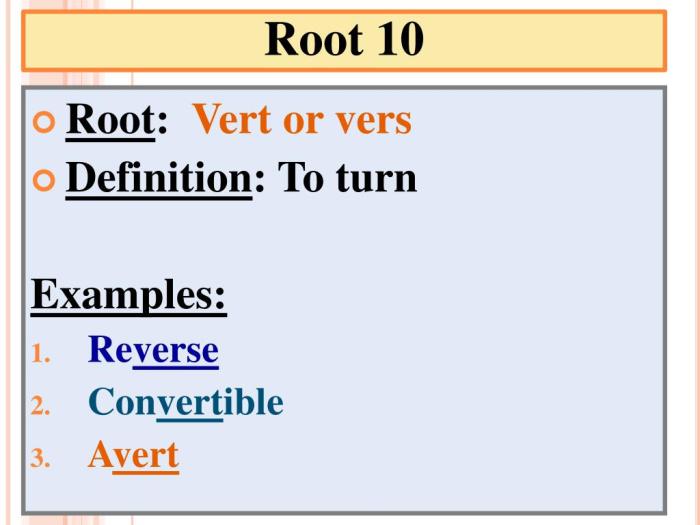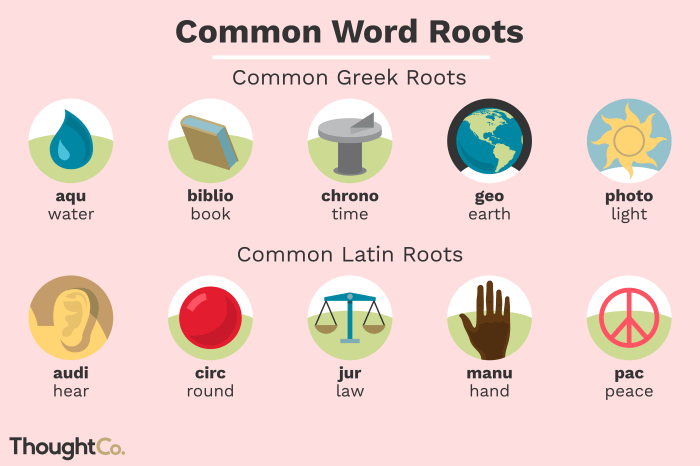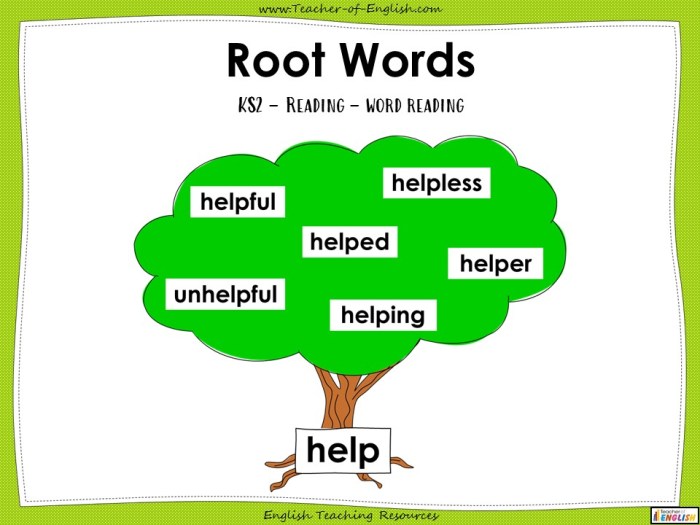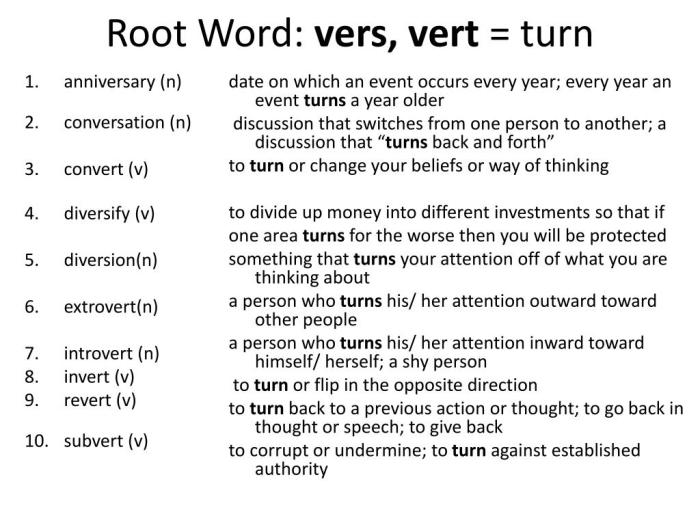As words with the root word vert take center stage, this opening passage beckons readers into a world crafted with words, ensuring a reading experience that is both absorbing and distinctly original.
Words with the root word vert span a vast semantic range, encompassing concepts of greenness, growth, and vitality. From verdant landscapes to vibrant hues, the root vert paints a vivid tapestry of meaning across diverse languages and cultures.
Root Word ‘Vert’ Etymology
The root word ‘vert’ originates from the Latin word ‘vertere’, which means ‘to turn’ or ‘to change’. It has been adopted into various languages and has evolved to encompass a wide range of meanings related to turning, direction, and change.
Latin Origins
In Latin, ‘vertere’ was a versatile verb with several meanings, including ‘to turn’, ‘to change’, ‘to translate’, and ‘to interpret’. Its usage extended beyond physical actions, encompassing abstract concepts such as changing one’s mind or translating ideas.
Romance Languages
The root ‘vert’ spread throughout the Romance languages, which evolved from Latin. In French, ‘vert’ became ‘vert’, meaning ‘green’, likely due to the association of green with vegetation and growth. In Spanish, ‘verter’ retained its original meaning of ‘to pour’ or ‘to spill’.
English
The root ‘vert’ entered English through various channels. The word ‘vertex’ derives from the Latin ‘vertere’, referring to the highest point or turning point. ‘Vertical’ and ‘vertigo’ also have Latin origins, signifying ‘upright’ and ‘dizziness’ respectively.
Other Languages
The root ‘vert’ has also influenced other languages beyond the Romance family. In German, ‘verteilen’ means ‘to distribute’, while in Russian, ‘вертеть’ (vertet’) means ‘to spin’ or ‘to rotate’.
Semantic Range of ‘Vert’

The root word ‘vert’ originates from the Latin word ‘vertere’, meaning ‘to turn’. This root has given rise to a wide range of words in English, each carrying distinct meanings and connotations.
Words that share the root ‘vert’ encompass concepts related to turning, changing, or altering. These words can be broadly categorized into three main semantic groups:
Direction and Position
This group includes words that describe direction, position, or movement. Examples include:
- Vertical: Upright or perpendicular to the ground.
- Versatile: Able to turn or adapt easily to different situations.
- Vertex: The highest point of a curve or angle.
Change and Transformation
Words in this group convey ideas of change, transformation, or alteration. Examples include:
- Convert: To change or transform something into another form.
- Invert: To turn something upside down or reverse its order.
- Revert: To return to a previous state or condition.
Speech and Communication
Finally, some words with the root ‘vert’ relate to speech and communication. Examples include:
- Verbal: Spoken or written words.
- Verbose: Using many words or details.
- Versatile: Capable of expressing oneself effectively in different ways.
‘Vert’ in Language Families
The root word ‘vert’ and its derivatives have made their way into several language families, each leaving its unique imprint on the usage and evolution of this word.
Across these families, ‘vert’ often carries connotations of greenness, growth, and freshness, reflecting its Latin origins. However, subtle variations in meaning and usage have emerged, influenced by the cultural and linguistic contexts of each language family.
Indo-European Family
- In Romance languages like French, Spanish, and Italian, ‘vert’ retains its association with green and is commonly used to describe vegetation and nature.
- In Germanic languages such as English, German, and Dutch, ‘vert’ has evolved into ‘green’ or ‘verdant,’ focusing more specifically on the color aspect.
Semitic Family
- In Arabic, the root ‘wrd’ is related to ‘vert’ and conveys meanings of freshness, prosperity, and blooming.
- In Hebrew, ‘ya’ar’ is derived from ‘vert’ and refers to a forest or woodland, highlighting the connection between ‘vert’ and natural environments.
Uralic Family, Words with the root word vert
- In Finnish, ‘vihreä’ is derived from ‘vert’ and primarily denotes the color green, similar to its Germanic counterparts.
- In Hungarian, ‘zöld’ is related to ‘vert’ and carries a broader meaning encompassing both greenness and freshness.
‘Vert’ in Literature and Poetry

Words with the root ‘vert’ have been used extensively in literature and poetry throughout history, contributing to the depth and richness of these works. The semantic range of ‘vert’ allows authors to convey a wide range of themes, imagery, and emotions.
Literary Works Featuring ‘Vert’
Some notable examples of literary works that feature words with the root ‘vert’ include:
- William Shakespeare’s Romeo and Juliet: The play contains several references to ‘vert’ and its derivatives, such as “green” and “verdant.” These references often symbolize the youth and vitality of the young lovers, as well as the natural world that surrounds them.
- John Milton’s Paradise Lost: Milton uses the word “vert” to describe the lush and vibrant landscape of Eden, contrasting it with the barren and desolate wasteland of Hell.
- William Wordsworth’s Ode: Intimations of Immortality: Wordsworth’s poem explores the theme of the loss of childhood innocence, and the word “vert” is used to symbolize the natural world that the speaker longs to return to.
Contribution to Themes and Imagery
The use of ‘vert’ in literature and poetry can contribute to various themes and imagery:
- Nature and the Environment: Words with the root ‘vert’ are often used to describe the natural world, evoking images of lush landscapes, verdant forests, and vibrant ecosystems.
- Youth and Vitality: The association of ‘vert’ with green and growing things can symbolize youth, energy, and the promise of new beginnings.
- Tranquility and Renewal: The soothing and calming qualities of nature are often conveyed through the use of ‘vert’ and its derivatives, creating a sense of tranquility and renewal.
Overall, the use of ‘vert’ in literature and poetry enriches the works’ themes, imagery, and emotional impact, allowing authors to explore a wide range of ideas and emotions through the power of language.
‘Vert’ in Scientific and Technical Terminology

The root ‘vert’ finds its way into various scientific and technical fields, where it conveys distinct meanings and serves specific functions.
In the realm of computer science, ‘vert’ often refers to a vertex, a fundamental concept in computer graphics. A vertex represents a single point in 3D space, and a collection of vertices forms the foundation for creating complex 3D models.
Computer Graphics
- Vertices define the shape and structure of 3D models.
- They are used in conjunction with edges and faces to create polygons, which form the building blocks of 3D objects.
Moving to the field of physics, ‘vert’ surfaces in the context of sound waves. A vertical wave is one that oscillates up and down perpendicular to the direction of wave propagation. This type of wave is commonly encountered in acoustics and seismic studies.
Acoustics and Seismology
- Vertical waves are characterized by their up-and-down motion, unlike horizontal waves that move side-to-side.
- They are particularly relevant in studying sound waves in enclosed spaces and seismic waves traveling through the Earth’s layers.
In the realm of aviation, ‘vert’ takes on a different meaning. Vertical takeoff and landing (VTOL) aircraft are designed to ascend and descend vertically, enabling them to operate in confined spaces or on surfaces where conventional runways are impractical.
Aviation
- VTOL aircraft employ specialized propulsion systems that generate vertical thrust, allowing them to lift off and land without the need for a runway.
- Examples include helicopters, Harrier jump jets, and the F-35B Lightning II.
‘Vert’ in Cultural and Historical Contexts

Throughout history, ‘vert’ has played a significant role in shaping cultural perspectives and influencing social interactions. From its origins in Latin, ‘vert’ has evolved into a versatile term that encompasses concepts of greenness, vitality, and prosperity.
In many cultures, the color green has been associated with nature, growth, and renewal. For example, in ancient Egypt, the goddess Isis was often depicted with green skin, symbolizing her connection to the fertile Nile River valley. Similarly, in Celtic traditions, the color green was believed to possess magical properties and was often used in rituals and ceremonies.
Green as a Symbol of Wealth and Status
In some societies, the color green has also been associated with wealth and status. For example, in medieval Europe, wealthy merchants and nobles often wore green clothing to display their affluence. This association between green and prosperity continues to this day, with many cultures using the color green in their flags and currencies.
Green as a Symbol of Environmentalism
In recent decades, the color green has become increasingly associated with environmentalism and sustainability. This association stems from the growing awareness of the importance of protecting the natural environment. As a result, many organizations and individuals have adopted green as a symbol of their commitment to environmental protection.
Green as a Symbol of Peace
In some cultures, the color green has also been associated with peace and tranquility. For example, in Japan, the green tea ceremony is seen as a way to promote relaxation and harmony. Similarly, in many Western cultures, the color green is often used to symbolize peace and hope.
‘Vert’ in Contemporary Usage
In contemporary usage, ‘vert’ has retained its original meaning of “green” and expanded to encompass various contexts, including social media, popular culture, and everyday language. The term has evolved to denote not only the color green but also concepts associated with it, such as sustainability, growth, and environmentalism.
Words with the root word vert, meaning to turn or revolve, often relate to objects in motion. Like the revolving flask in a flask that weighs 345.8 g , these words capture the essence of movement and change.
Social Media and Popular Culture
On social media platforms, ‘vert’ is often used as a hashtag (#vert) to tag posts related to environmental issues, nature appreciation, and eco-friendly lifestyles. In popular culture, the term has gained prominence in various forms, including:
- Vert skateboarding:A skateboarding style characterized by performing tricks on ramps and other vertical surfaces.
- Vert racing:A form of racing that involves navigating vertical obstacles and ramps.
- Greenwashing:A marketing strategy that presents a company or product as environmentally friendly when it is not.
Everyday Language
In everyday language, ‘vert’ has become synonymous with “sustainable” or “eco-friendly.” It is commonly used in contexts such as:
- Vert products:Products designed with environmental sustainability in mind.
- Vert practices:Practices that minimize environmental impact.
- Vert living:A lifestyle that emphasizes environmental consciousness.
Overall, the contemporary usage of ‘vert’ reflects the growing importance of environmentalism and sustainability in modern society.
‘Vert’ in Art and Design

The root word ‘vert’ finds its way into the realm of visual arts, architecture, and design, inspiring creativity and shaping aesthetic choices. Whether it’s the vibrant hues of a painting or the towering heights of a building, ‘vert’ influences the way artists and designers express themselves.
In painting, ‘vert’ encompasses the entire spectrum of greens, from the soft and delicate to the bold and intense. Artists use these shades to evoke a wide range of emotions and create a sense of depth and perspective. From the verdant landscapes of Impressionism to the vibrant abstracts of modern art, ‘vert’ plays a crucial role in conveying the artist’s vision.
Architecture and Design
In architecture and design, ‘vert’ manifests in the vertical elements that define a space. Columns, pillars, and walls create a sense of height and grandeur, while windows and doors provide vertical openings that connect the interior and exterior.
The interplay of vertical and horizontal lines creates a dynamic and visually appealing aesthetic. Architects and designers use ‘vert’ to create a sense of balance, proportion, and rhythm in their designs.
‘Vert’ in Education and Linguistics

Understanding words with the root ‘vert’ holds immense pedagogical value. By delving into their etymological origins and semantic range, students gain insights into the evolution of language and the interconnectedness of words. This exploration enhances their vocabulary development, improves reading comprehension, and fosters a deeper appreciation for the intricacies of language.
Vocabulary Development
Studying ‘vert’ expands students’ vocabulary by introducing them to a range of words sharing a common root. Through exposure to terms like ‘vertical,’ ‘vertex,’ and ‘divert,’ students learn the nuances of word formation and the relationship between root words and their derivatives.
This enriched vocabulary enables them to express themselves more precisely and effectively.
Reading Comprehension
An understanding of ‘vert’ enhances reading comprehension by providing a foundation for deciphering unfamiliar words. When encountering words like ‘invertebrate’ or ‘subvert,’ students can draw upon their knowledge of the root ‘vert’ to infer their meaning. This ability to connect words to their roots empowers students to tackle complex texts with greater confidence and understanding.
Language Appreciation
Exploring ‘vert’ cultivates a deeper appreciation for language. By tracing the root’s historical evolution and examining its usage across different languages, students gain a sense of the fluidity and dynamism of language. This understanding fosters a lifelong curiosity about the intricacies of communication and a respect for the power of words.
‘Vert’ in Cross-Cultural Communication
Words with the root ‘vert’ often carry complex and culturally-specific meanings, posing challenges and opportunities in cross-cultural communication. To bridge these gaps, effective strategies are crucial to convey intended messages and avoid misunderstandings.
Strategies for Effective Communication
- Contextualize Meaning:Provide additional information to clarify the intended meaning in a specific cultural context.
- Avoid Slang or Idioms:Slang and idioms may have different interpretations across cultures, leading to confusion.
- Be Aware of Cultural Connotations:Understand the cultural associations and connotations of words to avoid unintended implications.
- Use Visual Aids:Visual aids, such as images or graphs, can transcend language barriers and enhance comprehension.
- Encourage Active Listening:Encourage participants to ask questions and clarify any uncertainties to ensure understanding.
Avoiding Potential Misunderstandings
- Be Patient and Respectful:Allow time for understanding and respect cultural differences in communication styles.
- Avoid Assumptions:Do not assume that the meaning of words is universally understood; clarify meanings explicitly.
- Use Feedback Mechanisms:Seek feedback from participants to ensure comprehension and identify areas of misunderstanding.
- Embrace Cultural Exchange:Engage in cultural exchange to gain insights into different perspectives and avoid ethnocentrism.
- Be Open to Learning:Continuously learn about different cultures and their linguistic nuances to improve cross-cultural communication.
Commonly Asked Questions: Words With The Root Word Vert
What is the origin of the root word vert?
The root word vert traces its origins to the Latin word viridis, meaning “green”.
How is the root word vert used in different languages?
The root word vert is found in various languages, including English, French, Spanish, Italian, and German, with slight variations in spelling and pronunciation.
What are some examples of words that share the root word vert?
Examples of words that share the root word vert include verdant, viridescent, verdure, vortex, and vertigo.